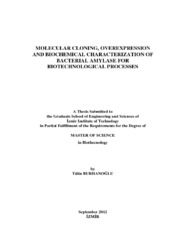Please use this identifier to cite or link to this item:
https://hdl.handle.net/11147/3502| Title: | Molecular Cloning, Overexpression and Biochemical Characterization of Bacterial Amylase for Biotechnological Processes | Authors: | Burhanoğlu, Tülin | Advisors: | Karakaya, Hüseyin Çağlar Şanlı Mohamed, Gülşah |
Publisher: | Izmir Institute of Technology | Abstract: | Amylases are the enzymes that act on glycosidic bond of starch and related polysaccarides. They comprise 25% of enzyme utilised in a variety of industry. It is used to obtain maltose, glucose and maltodextrins in various lenghts during industrial processes. Amylases are widely distributed enzymes in bacteria, fungi, higher plants and animals. Thermophilic enzymes are widely demanded in order to be stable at harsh process conditions. Isolating these enzymes from thermophilic microorganism is increasing trend because of ease of enzyme production. In this study α-amylase gene region from a thermophilic Bacillus sp. isolated from Balçova Geotermal region in İzmir was cloned to compotent E. coli BL 21 cells. Additionally protein expression was reinforced with pKJE7 chaperone plasmid. Cloned gene was sequenced and found as 1542 bp in length. Thermophilic amylase that has a 59.9 kD molecular weight was expressed and purified from this recombinant strain. Mass spectrometric analysis were performed and the enzyme was matched with α-amylase family protein of Geobacillus thermodenitrificans NG80-2 using NCBInr database. The aminoacid sequence of this enzyme was seen to be similar 92% with our obtained enzyme. According to the results of characterization studies, the amylase enzyme was seen to have highest activity at pH 8.0 and 60°C. The enzyme was also showed to have resonable activity between pH5 and 9. 85% of the enzyme activity was retained at 70°C. Furthermore, amylase activities at 65 and 85°C were observed to remain stable for 5 and 2 hours, respectively. It was also showed that the activity was stable and pH7 and 9 for 6 hours. The effects of some metal ions, chemical agents and organic solvents on enzyme activity were examined so, Co+2, Mg+2,Ca+2 was determined to be as inducer for the enzyme activity. Conversely the activity was inhibited by Cu+2. Furthermore methanol, DDT and Triton X-100 was found to have no effect on the enzyme activity. | Description: | Thesis (Master)--Izmir Institute of Technology, Biothechnology, Izmir, 2012 Includes bibliographical references (leaves: 47-53) Text in English; Abstract: Turkish and English xi, 59 leaves |
URI: | http://hdl.handle.net/11147/3502 |
| Appears in Collections: | Master Degree / Yüksek Lisans Tezleri |
Files in This Item:
| File | Description | Size | Format | |
|---|---|---|---|---|
| T001046.pdf | MasterThesis | 1.53 MB | Adobe PDF |  View/Open |
CORE Recommender
Page view(s)
50,888
checked on Jun 16, 2025
Download(s)
138
checked on Jun 16, 2025
Google ScholarTM
Check
Items in GCRIS Repository are protected by copyright, with all rights reserved, unless otherwise indicated.